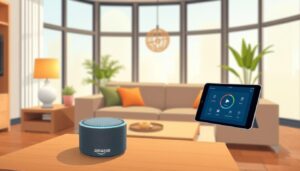Many homeowners look for smart ways to improve their property’s safety. A popular and effective method involves installing automated security lighting. These systems activate only when needed, providing illumination exactly where and when it matters most.
This guide will walk you through creating your own system. You can build a setup that fits your specific needs. The process offers complete control over features like sensitivity and duration.
Building your own security lighting has clear advantages. It often costs less than buying pre-made units. You also gain the ability to customize every aspect. This project can range from a simple indoor nightlight to a full outdoor security solution.
We will cover planning, assembly, and installation in the following sections. You can achieve professional-grade results with a hands-on approach. This empowers you to enhance your home’s protection and efficiency.
Understanding Your DIY Motion Sensor Lights Project
Home protection strategies increasingly rely on responsive lighting that engages only when necessary. This approach saves energy while providing illumination exactly when you need it most.
Project Overview and Benefits
These automated systems detect movement using passive infrared technology. PIR components identify heat signatures from people and animals. The system then activates your chosen illumination source.
Customization represents the primary advantage of building your own system. You control how long lights stay on after activation. You also adjust detection range and brightness levels.
How Motion Sensors Enhance Security
Automated detection creates a powerful security presence. Sudden illumination startles potential intruders. It also gives homeowners visibility when investigating unusual activity.
The system creates the impression of occupancy even when you’re away. This psychological deterrent proves highly effective. You gain peace of mind knowing your property has intelligent protection.
Key security benefits include:
- Reduced energy consumption through targeted activation
- Customizable sensitivity for different areas
- Scalable solutions from single rooms to entire properties
Gathering Essential Supplies and Tools
Before diving into construction, gathering the right materials ensures smooth assembly. Proper preparation prevents delays and guarantees professional results.
Required Electronics and Hardware Components
Your component selection depends on the system complexity you choose. Basic setups require a PIR detection unit, microcontroller, and illumination source.
The PIR sensor detects heat signatures from moving objects. Models with built-in indicators simplify testing. Choose between compact ATtiny85 boards or Arduino Pro Mini for processing.
Light-dependent resistors prevent daytime activation. They measure ambient brightness levels. Proper resistor selection protects your LED from excessive current.
Power options range from battery packs to 12V adapters. Consider your installation location when choosing the energy source. Rechargeable batteries offer eco-friendly operation.
Recommended Tools for Circuit Building
Quality tools make assembly efficient and safe. A soldering iron creates permanent connections between components. Wire strippers prepare cables for proper installation.
Multimeters verify voltage levels throughout your circuit. This prevents damage to sensitive electronics. Drills create mounting holes for sensors and enclosure placement.
Breadboards allow temporary testing before final assembly. This helps identify wiring issues early. Proper tools ensure your security system functions reliably.
Planning the Circuit: Components and Wiring
A well-designed electrical layout forms the foundation of any reliable detection system. Proper organization prevents malfunctions and ensures consistent performance across different conditions.
Reviewing the Circuit Schematic
The ATtiny85 configuration connects the PIR sensor’s center pin to a digital input for detection. The left pin receives 5V supply while the right pin establishes the ground connection.
An LDR and 1kΩ resistor create a voltage divider on pin 2. This arrangement measures ambient light conditions effectively. The LED connects through a 100Ω resistor to a PWM-capable output pin.
Arduino setups typically use digital pin 10 for the PIR signal wire. Power connects to the 5V pin with ground to GND. The LED requires a 22Ω resistor on pin 3.
Best Practices for Wiring and Layout
Minimize wire lengths to reduce resistance and electrical noise. Secure all connections through soldering for permanent installations. Route power lines separately from signal wires.
Position PIR sensors with clear views of monitored areas. Place LDRs where they receive accurate ambient light samples. Central microcontroller placement minimizes interconnection distances.
Proper ground connections prevent voltage fluctuations and erratic behavior. Current-limiting resistors protect LEDs from excessive current flow. These practices ensure long-term reliability.
Setting Up the ATtiny85 and Arduino Environment
Programming microcontrollers forms the crucial bridge between hardware assembly and functional security systems. Proper configuration ensures your detection logic operates reliably. This phase transforms static components into an intelligent unit.
Installing ATtiny85 Support in Arduino
The Arduino IDE requires additional board support packages for ATtiny chips. These packages provide necessary libraries and compiler settings. You add them through the Boards Manager interface.
Select “ATtiny25/45/85” as your target board after installation. Choose the specific ATtiny85 processor variant. The internal 1 MHz clock speed works perfectly for detection applications.
Programming Using AVRISP mkII and Alternatives
Several programming devices interface between computers and microcontrollers. The Atmel AVRISP mkII offers reliable performance under $50. SparkFun and Pololu provide excellent alternative programmers.
Critical requirement: The AVRISP mkII needs external 5V power during programming. Connect this supply to your chip’s VCC pin. A modified USB cable easily provides this power.
Follow precise pin mappings between programmer and microcontroller. MISO, SCK, MOSI, and RESET connections must match exactly. Proper wiring establishes successful communication.
Use “Upload Using Programmer” from the Sketch menu instead of the standard upload button. This method writes firmware directly without bootloader intermediation. Your code transfers efficiently to the chip.
Integrating Sensors: PIR, LDR, and LED Configuration
Successful automation depends on how effectively different sensing technologies work together. Proper coordination between detection components ensures your system responds intelligently to environmental changes.
Understanding PIR Sensor Functionality
Passive infrared technology detects thermal radiation from warm objects. These devices use specialized lenses to focus infrared signatures onto sensitive elements.
The PIR sensor generates electrical signals when temperature changes occur within its detection zone. This creates the foundation for reliable movement detection. Different trigger modes offer flexibility for various applications.
Single-trigger mode provides brief output pulses after each detection event. Repeating-trigger mode maintains continuous output during sustained activity. Sensitivity adjustments customize detection range from three to seven meters.
Optimizing LDR Placement and LED Brightness
Light-dependent resistors measure ambient illumination levels accurately. Their resistance changes proportionally with light intensity. This prevents unnecessary daytime activation.
Strategic LDR placement avoids interference from your own LED output. Position these components toward natural light sources for optimal performance. This ensures accurate day/night discrimination.
Pulse-width modulation controls LED brightness through rapid cycling. This creates apparent dimming effects without visible flickering. Color selection affects both visibility and user comfort during nighttime use.
Red or green alternatives often work better for bedroom applications. They provide adequate illumination with reduced sleep disruption. White options deliver maximum brightness for security-focused installations.
Implementing Motion Sensor Lights DIY Software Logic
The programming phase brings your security lighting project to life by defining its intelligent behavior. This code determines how your system responds to environmental changes and user movements.
Well-structured software follows a clear sequence of operations. It continuously monitors for activity, checks lighting conditions, and controls illumination output.
Writing and Adjusting the Code
Your program begins by initializing pins and establishing communication with components. A crucial warm-up period allows the detection unit to stabilize properly.
The main logic operates in a continuous loop. It checks the activity detection pin at regular intervals. When activity is confirmed, the system evaluates ambient brightness levels.
Key programming considerations include:
- Blocking loops that pause operation while waiting for detection signals
- Configurable light thresholds that determine activation conditions
- Adjustable timing parameters controlling illumination duration
- Visual feedback during initialization through LED blinking patterns
Using PWM to Control LED Output
Pulse-width modulation creates variable brightness levels through rapid cycling. This technique allows precise control over illumination intensity without visible flickering.
You define brightness percentages in your code settings. Lower values create subtle lighting effects for bedrooms. Higher percentages deliver stronger illumination for security applications.
The PWM implementation works by switching the LED on and off thousands of times per second. Different duty cycles create the appearance of dimming or brightening. This approach conserves power while providing flexible lighting options.
Testing and Troubleshooting Your Installation
Systematic verification ensures your detection system operates reliably after assembly. Proper testing identifies potential issues before final deployment. This phase confirms all components work together as intended.
Verifying Sensor Connections and Signal Flow
Begin by checking all electrical pathways. Use a multimeter to confirm voltage levels at microcontroller pins. This ensures adequate operating power throughout your circuit.
Test each component independently for accurate function. The detection unit should output approximately 3.3V when activity occurs. Cover the light-sensitive component to simulate darkness and verify threshold triggering.
Connection verification prevents most installation challenges. Confirm pin configurations match manufacturer specifications. Visual inspection combined with datasheet reference eliminates wiring errors.
Debugging Common Issues
Several typical problems may arise during testing. If illumination fails despite activity, check your power supply voltage. Ensure it remains within the operating range under load conditions.
Constantly lit output often indicates positioning errors. The light-sensitive component may detect its own output rather than ambient conditions. Reposition it toward natural light sources away from illumination paths.
Allow sufficient initialization time after power application. Detection units require 10-60 seconds to stabilize. Horizontal movement across the unit typically works better than direct approaches.
Intermittent operation frequently results from temporary connections. Migrate to soldered assemblies for permanent installations. This ensures mechanically secure, low-resistance pathways.
Enhancing the Installation: Project Box and Mounting Tips
Strategic component placement within protective housing ensures optimal performance and longevity. The enclosure transforms your electronic assembly into a durable, professional installation that withstands daily use.
Designing a Secure and Clean Layout
Proper planning of your component arrangement prevents interference and maximizes functionality. Each element requires specific positioning for ideal operation.
The detection unit needs an unobstructed view of the monitored area. Position it to capture horizontal movement effectively. The light-sensitive component should face natural light sources away from your illumination output.
Drilling preparation begins with careful measurement and marking. Use a 1mm bit for standard component leads. Larger openings accommodate mechanical fasteners for heavier components.
Key installation considerations include:
- Solid-core wiring maintains shape for precise component positioning
- Female headers enable easy LED replacement and color changes
- PCB integration provides organized mounting with reduced wire lengths
- Mechanical fasteners ensure secure attachment of heavier components
Location selection balances detection reliability with prevention of false triggers. Ceiling mounting near room corners often works well. Make sure to verify absence of hidden wiring before drilling.
The final assembly typically involves mounting the top piece first. Then attach the base containing your populated circuit. This approach creates a clean, professional finish.
Wrapping Up Your Motion Sensor Lights DIY Journey
Completing this hands-on electronics project delivers both immediate benefits and lasting knowledge. Your custom-built system now provides automated illumination exactly when needed.
The practical advantages include enhanced home security and significant energy savings. You’ve created a solution that activates only during actual use.
This project scales beautifully from simple single-unit setups to complex multi-zone networks. The skills you’ve gained in microcontroller programming and component integration apply to countless future electronics endeavors.
Make sure to document your final installation with photos and schematics. This facilitates future modifications and troubleshooting. Proper documentation ensures long-term reliability.
Your journey ends with a functional system that combines security with efficiency. The knowledge gained empowers you to tackle more advanced home automation projects with confidence.



